|
Bangkok Ayutthaya Klong Sa Bua Floating Market & Water Theatre Amphawa Floating Market Map of Amphawa Floating Market
The distances and the heat make this one of the world’s least walkable cities. It’s well worth taking a tour in an air-conditioned coach or car—the driver ought to be able to avoid the worst of the traffic jams.
 A good place to start is Royal Bangkok, the oldest part of the city on the Chao Phraya river. The Grand Palace is a fabulous complex where royal, religious and government buildings huddle together inside a crenellated wall. Among the pinnacles and spires, gateways guarded by oriental monsters, banquet halls and cloisters, Wat Phra Kaeo stands out. It is the royal chapel and Temple of the Emerald Buddha, protected by a nine-tiered umbrella and surrounded by gold murals. The Emerald Buddha is made of jade and considered so sacred that the king himself brings it ritual offerings and changes its seasonal dress. The centrepiece of the complex is Chakri Maha Prasad, topped by a chedi (shrine). A golden urn beneath the central spire contains the ashes of the Chakri kings. A good place to start is Royal Bangkok, the oldest part of the city on the Chao Phraya river. The Grand Palace is a fabulous complex where royal, religious and government buildings huddle together inside a crenellated wall. Among the pinnacles and spires, gateways guarded by oriental monsters, banquet halls and cloisters, Wat Phra Kaeo stands out. It is the royal chapel and Temple of the Emerald Buddha, protected by a nine-tiered umbrella and surrounded by gold murals. The Emerald Buddha is made of jade and considered so sacred that the king himself brings it ritual offerings and changes its seasonal dress. The centrepiece of the complex is Chakri Maha Prasad, topped by a chedi (shrine). A golden urn beneath the central spire contains the ashes of the Chakri kings.
Cha-Am Google Map with Shops - Restaurant - Bank -
and other things
Across the road from all the royal grandeur is a small structure housing the Lakmuang or foundation stone of Bangkok. Local people surround it with flowers, candles and incense. On the fringes, people sell food, amulets and lottery tickets. Outside, passersby are asked to buy birds, not to keep but to release as an act of piety.
The country’s treasures, displayed in the National Museum, are so extensive and exotic that you may be overwhelmed. The most interesting items include pots and jars with haunting designs, probably 5,000 years old. Metropolitan Bangkok counts dozens of wats—Buddhist monasteries or temple complexes. The 16th-century Wat Pho near the Grand Palace, with a stupendous gilt reclining Buddha and much other art, is the city’s oldest and biggest monastery.

Wat Arun (Temple of the Dawn) stands on the opposite bank of the river, only a minute or so away by ferry. The central tower, taller than a 20-storey building looms like an elongated Aztec pyramid. The most popular excursion in Bangkok, the Floating Market Tour, explores the Chao Phraya River and some of the klongs (canals) to the west of the city. Early in the morning is the best time to catch the vendors on their rounds, paddling past the canal-front houses. Included in the tour is a visit to the Royal Barge Museum, home of otherworldly dreamboats with elaborate red and gold decorations.
What to see in Thailand
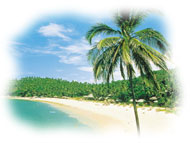
Bangkok has no real city centre, but several neighbourhoods, widely dispersed, call for attention. Northeast of the Grand Palace, a wide, leafy boulevard, Ratchadamnoen Nok, is lined with government office buildings, often with steep traditional roofs. It leads to the Marble Temple, Wat Benchamabophit, a haven of calm. Chinese tiles cover the interlaced roofs, and a pair of huge marble lions guard the entrance to the bot (shrine). In Chinatown, every shop window brings a new discovery, from snake wine to paper dragons. Wat Traimit houses a Golden Buddha seven or eight centuries old, weighing 5 tonnes. Further east, the area around Siam Square has cinemas, restaurants and shopping centres. Jim Thompson’s House, the cluttered home of a devoted collector, is full of oriental art. Thompson put the Thai silk industry on the map, then vanished on holiday in Malaysia in 1967.
Across the railway line, in the eastern part of the city, Sukhumvit Road marks the beginning of a shopping, entertainment and residential district.
Near the river, to the south, Charoen Krung Road (or New Road), was the first official road in Thailand. Around the General Post Office is one of the original shopping areas, still well supplied with souvenir shops and “instant” tailors. A final “town centre” runs northeast of the New Road district along Silom and Surawong, two parallel thoroughfares. The financial and commercial tone of the zone is overshadowed by the notoriety of two small streets, Patpong I and II. From Munich to Melbourne, the name Patpong evokes the image of go-go bars and massage parlours. The seamy reality certainly matches the reputation, even if moral campaigns and a growing incidence of crime have put a damper on its former ebullience.
The Rose Garden, a private resort west of Bangkok, stages a Thai Village Cultural Show, offering a comprehensive introduction to Thai music, dance and traditional sports. Nearby Nakhon Pathom boasts the tallest Buddhist monument in Thailand—the Phra Pathom chedi, 120 m (395 ft) high. Tours in the area can take in the floating market of Damnoen Saduak, a more relaxed and less commercial affair than that of Bangkok.
River Kwai Bridge
Near Kanchanaburi, 130 km (80 miles) west of Bangkok, Allied prisoners-of-war held by the Japanese in World War II were forced to build a section of the notorious Death Railway to Burma, including a bridge over the River Khwae Yai (or Kwai). That bridge was destroyed by bombing in 1945, but parts can still be seen in its replacement. Sound and light shows are sometimes staged at the bridge, and it’s possible to take a short ride on the railway. The war cemetery at Kanchanaburi contains the graves of thousands of prisoners who died during its construction.
Pattaya
One of Asia’s best-known beach resorts is a fun-and-sun whirl on the lovely shores of the Gulf of Thailand. You could spend the day sleeping under a thatch umbrella on the vast beach, but it’s hard to stay aloof from all the activity: children riding horses or little elephants; hawkers selling sarongs, beads, food and drink; itinerant masseuses; and, of course, every sort of water sport. The shallows get jam-packed with swimmers, pedalos and jet-skis, but dozens of boats offer excursions to nearby islands for swimming and snorkelling in superb clear water.
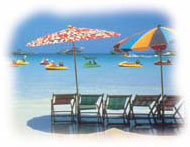 Landward tours visit a rubber plantation, a gemstone mine and the Elephant Kraal where the gentle giants show off their skills. Shopping centres on the main street of south Pattaya and in the hotel boutiques. Off-the-peg fashion, shells, jewellery and trinkets catch the eye. Nightlife, also concentrated round south Pattaya, includes discos and open-air bars with some of the same dubious attractions as Bangkok’s Patpong. Hotel nightclubs put on a variety of musical shows. Landward tours visit a rubber plantation, a gemstone mine and the Elephant Kraal where the gentle giants show off their skills. Shopping centres on the main street of south Pattaya and in the hotel boutiques. Off-the-peg fashion, shells, jewellery and trinkets catch the eye. Nightlife, also concentrated round south Pattaya, includes discos and open-air bars with some of the same dubious attractions as Bangkok’s Patpong. Hotel nightclubs put on a variety of musical shows.
Hua Hin
King Rama VII chose Hua Hin in the 1920s as the place for a seaside villa. To this day the royal family spends some of the year here, and the resort retains something of an exclusive air.
With fewer hotels, mostly discreet, low-rise buildings beside pools, everything functions at a less frenetic pace. The gentle slope of the 3-km (2-mile) beach is ideal for children; there’s a full range of water sports and a golf course. Nightlife, too, is a quieter affair in this peaceful retreat. The nearby town of Hua Hin is a lively fishing port.
Cha-Am
Cha-am is a younger version of Hua Hin, a leisurely family weekend resort, which has maintained its unique identity. During the week it's all peace and quiet, the ideal place to get away. Thai people come to the beach for their picnics, swimming and to just relax.
Cha-Am lies on the premier beach resort of Petchaburi on the sunrise side of the Gulf of Thailand, 163 km south of Bangkok. The landscape here is characterized by dense jungles and mountain ranges. A leisurely drive from Bangkok takes about 2.5 hours.
Once a fishing village, Cha-Am offers a laidback pace of life, and a more tranquil atmosphere than neighboring Hua Hin beach. Its main appeal is its clean, white sand beach, which is thought to be the longest in Thailand, and which is where you will find a choice of excellent seafood restaurants.
When it comes to activities, there is much variety, from champagne picnics on the beach to energetic pursuits such as water sports and cycling. Take a tour of the ancient temples and pagodas that dot the surrounding area. Or pay a visit to the summer palace of King Rama VI (Marukhathaiyawan Palace) less than 10 km south of Cha-Am.
The hotel is also conveniently close to the Springfield Country Club, the Palm Hills Golf Resort and Cha-Am Forest Park.
On the weekends and public holidays both Cha-am and Hua Hin come alive as the Thai people enjoy themselves, dancing and singing on the beach.
 |
| POSING FOR A PHOTO IN FRONT OF THE KING'S SUMMER PALCE |
Over the past few years many tourists have discovered these two resorts that remain relatively unspoiled. Hua Hin is twenty-five Km to the south of Cha-am, with many western restaurants and more of a city atmosphere than Cha-am. The two resorts offer miles of very clean sandy beaches, which are protected by tall trees that help keep the hot midday sun at bay. The swimming is ideal for children in the safe shallow waters on the Gulf of Thailand seashore. In and around the towns there is plenty to see and do Temples, caves with Buddha images, national parks, waterfalls, and the Kings Palace are a few sites to take in. Both towns have local markets that are open daily from 6am to 11pm where one can obtain all the local Thai fruits. In Hua Hin, the Klai Kangwon (Far From Worries) Palace is still frequently used by members of the royal family and is open to the public for visits. It was built in 1928, by King Rama VII and remains until today an official royal residence. If you like sports, there's swimming, snorkeling, scuba diving, cycling, horseback riding, jogging tracks, and all the major hotels have fitness rooms available for hotel guests and at a very small charge for the use of the facilities if you are not a guest. Maybe you'd like to go out for the day aboard an authentic wooden Thai fishing boat. While there is no toilet, no berth, and absolute no luxury, this adventure is only for those who dare. It would be an experience you'd never forget, however.
Thailand is well known for its golf courses and these resorts have some of the best in the surrounding area. Designed by some of the world's top golfers, they offer a challenge even for the pros. Along its five-mile stretch of beach, Hua Hin provides the highest density of world-class golf courses anywhere in Thailand, and yet it's virtually undiscovered as an international Golf destination. Green-fees and other costs are currently among the lowest in the world while course maintenance and services are superb.

The Harbor:
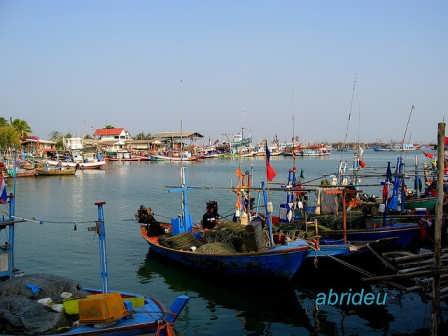
A lively place with a lot of fishing boats coming in and out. At the end of the harbor there is a very long promenade going into the sea.
Coming from the house (from North) there is a small wooden bridge where pedestrians, bikes and motorbikes can pass.
There are a number of restaurants where you can choose fish and seafood from basins for your dish.
There is one very good located restaurant at the far end near the promenade going into the sea.
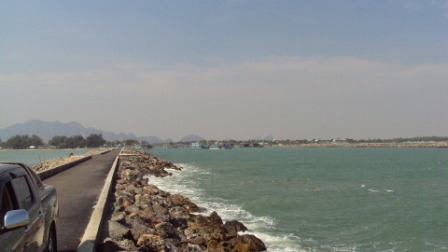

RESTAURANTS
Besides the restaurants in the vicinity of the House (The Shopkeeper, Eurasia, Hotel de la Paix and Mame) here are some suggestions:Bar and Nightlife
Restaurant Krua Klang Kluen
Going on the small roads along the beach towards Cha Am you will come to this restaurant app 800 meters after Mame Restaurant. It is on the beach itself. Many good and cheap dishes, especially seafood. Beware that some of the food is very hot. (To avoid this say “Nik Noi” when ordering).
Poom Seafood
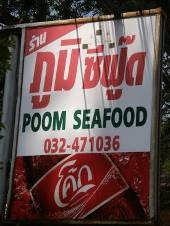
On the Promenade app 600 meters North of Narathip Road. Outdoor restaurant with a lot of white plastic chairs. An enormous menu and all dishes are very plentiful and very cheap. Filled with Thai people – a good sign.

Baan Pantai Café
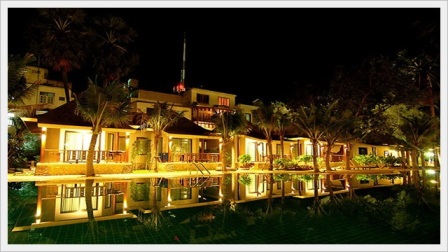
Restaurant/café on the promenade outside the big hotel. App 300 meters North of Narathip Road. The best coffee in town can be enjoyed here; OK food a bit pricy. Fine ice cream.
http://www.bannpantai.com/main.html

Mum’s Bistro
A very nice and cheap place is Mum’s Bistro, located just before you come to Narathip Road from the house – besides the bike-dealer and across Family Mart. Lovely food, great service and low prices. Yu can check on Tripsadvisor: http://www.tripadvisor.dk/Restaurant_Review-g297919-d2333703-Reviews-Mum_s_Bistro-Cha_am_Phetchaburi_Province.html
A-Roy Restaurant 
Very popular among foreigners because the menu offers both Thai and Western dishes. Fine food, OK service and fair prices. It is located on a parallel road to the Promenade. Come in from Narathip Road just before you reach the Promenade last road to the right – then app 100. A bit further is the road going down to the Promenade Soi 2 South, which is the red light district of Cha Am. A-Roy is on Tripadvisor:
http://www.tripadvisor.dk/Restaurant_Review-g297919-d2009675-Reviews-Restaurant_Aroy-Cha_am_Phetchaburi_Province.html
Bo Baeo
This tiny restaurant should be mentioned. It is located just beside the river when you come from the house going to Cha Am, pass an iron bridge and the restaurant is on the right side. Here you can enjoy a great dish – a combination of barbecue and fondue. You order various kinds (shrimps, chicken, pork) and you will get a bowl where you cook vegetables in water and fry meat of shrimps on the side of the bowl. Great and very cheap. Choose the tables at the river side – they have built in coal grills.
Okay supermarked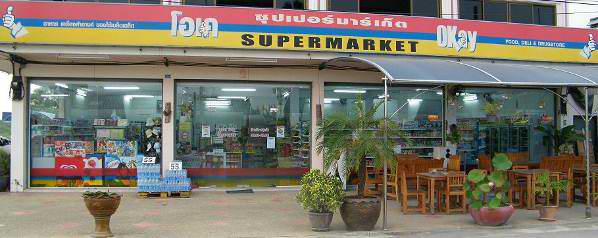
Great supermarket for foreigners. Located on Narathip Road on your right hand app 100 meters after you have come from Hospital Road. Here you can buy European stuff: wine, rye bread, sausages, canned food and sweets. It also sell used books in a lot of different languages. It is on Facebook:
https://www.facebook.com/pages/OKay-Supermarket/143738299067346?ref=ts&fref=ts

ToursBangkao
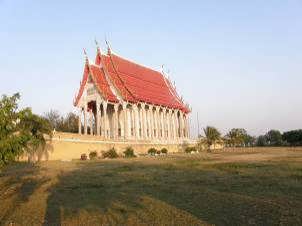
Coming to the main road from the house turn right (opposite Cha Am), after app 4 KM you reach the temple at Bangkao. Nice place to visit and monks might show you around. From the main road a small road is going to the sea – to the small fishing village of Bang Kao – certainly worth a visit.

Puek Tien Beach
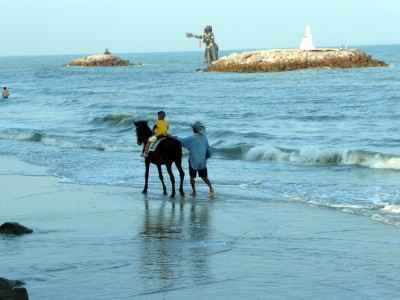
Puek Tien Beach is located app. 15 KM North of the House, going North on the main road (opposite direction of Cha Am). Keep an eye on the main road for the sign Puek Tien Beach and turn right to the sea. Here you can see some very big sculptures placed in the sea, mad after fairy tales of a famous Thai poet. There are several restaurants and a very nice café.
More info: http://www.around-chaam.com/puek-tian.html

Premium Outlet 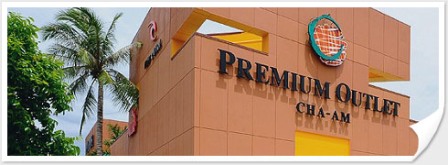 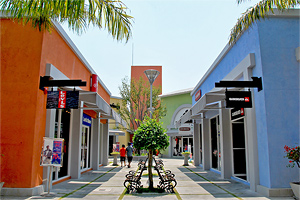
On the highway going around Cha Am (Bangkok-Hua Hin Road) there is a collection of 25 outlet shops, called Premium Outlet. From the House app 10 KM. Go to the main road from the Shopkeeper, but pass the main road go straight on inland. Go on for a couple of KM, pass the Forest Park (above) and when the road divides at a big tree go right/straight on. You end at the highway; you will have to go left for a little while then make a U-turn (going towards Bangkok). Premium is app 1 ˝ KM on your left side.
http://www.thaihoteldeals.com/guide/Premium-Outlet-Cha-am_USD_P.html
Khao Nang Phanturat Forest Park
You can climb on of these mountains. You go same route as going to Premium Outlet, but take a left when there as a sign of the Forest Park. Follow the signs and you are at the foot of the hill/mountain. There are various routes to go – from 2 KM to 3.5 KM. There is info center and a good restaurant at the foot. Monkeys and great nature.

National Park: Kaeng Krachan

The biggest national park in Thailand is app 50 KM from the House. You can make an arrangement with Mr Ud to make a tour. Biggest attraction is going on a boat in a lake, visiting Monkey Island.
http://www.dnp.go.th/parkreserve/asp/style1/default.asp?npid=113&lg=2
Phuket
The fact that two James Bond films have been shot in part near Phuket speaks volumes for Thailand’s exotic southern island paradise, epitomized by graceful palms and equally graceful people with their disarming openness and genuine hospitality. The population numbers more than 100,000, many of Chinese, Malaysian and Indian origin—not to mention the “Sea Gypsies”, a curiously reticent people who speak their own language and go their own singular way.
Hideaway island it may be, but Phuket (pronounced Poo-Ket) is by no means difficult to reach. A causeway links it by road with the mainland, providing easy access to motorists and coach passengers from Bangkok, 15 hours away. By air, travelling time is cut to just over an hour.
The sun-kissed, sparkling sand plus a clear blue sky and equally clear emerald-green sea and lush scenery make Phuket a perfect island retreat. The relatively recent influx of tourists slightly bewildered the islanders, who saw the Phuket lobster turn almost overnight into a sought-after delicacy. The lobster certainly does have a singular flavour, like many aspects of the island.
Whether you come for the sunTHBing, swimming and snorkelling—or simply to escape from the pace of everyday life—you’ll find an uncluttered corner somewhere. In spite of the drastic expansion of the island’s tourist industry, Phuket still lives up to its name as the pearl of southern Thailand. The former island capital, Thalang is located north of Phuket Town. No more than a village today, Thalang was besieged, then destroyed, by Burmese troops in 1809. Twenty-four years earlier, two Siamese sisters became folk heroines after they successfully defended the city against a month-long siege by the Burmese. The Heroine’s Monument shows the two women, barefoot and almost identical, swords still at the ready.
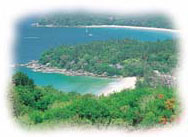 In Phuket Town itself, Thalang Road contains some two-storey houses in Sino-Portuguese style, reflecting the European influence of the 16th century. One of the prettiest views of the town—whether you want to see the sand sparkling in the sun or the lights twinkling at night—is from Phuket Hill. An equally colourful vantage point for any one of Asia’s dramatic sunsets is Laem Prom Thep, a headland 19 km (12 miles) south of Phuket Town. Stretching up into the sky is a photographer’s delight—a solitary palm tree silhouetted against the majestic hues of the setting sun. The picturesque Ton Sai Waterfall is set in the cool tropical greenery of the National Park, something of a relief to the eyes after Phuket’s shining sands. Just beyond it—north of the town at Wat Phra Tong—you can see the partly excavated golden Buddha which has defied all attempts to prise it from the ground. The statue remains half buried, protected by a screen. In Phuket Town itself, Thalang Road contains some two-storey houses in Sino-Portuguese style, reflecting the European influence of the 16th century. One of the prettiest views of the town—whether you want to see the sand sparkling in the sun or the lights twinkling at night—is from Phuket Hill. An equally colourful vantage point for any one of Asia’s dramatic sunsets is Laem Prom Thep, a headland 19 km (12 miles) south of Phuket Town. Stretching up into the sky is a photographer’s delight—a solitary palm tree silhouetted against the majestic hues of the setting sun. The picturesque Ton Sai Waterfall is set in the cool tropical greenery of the National Park, something of a relief to the eyes after Phuket’s shining sands. Just beyond it—north of the town at Wat Phra Tong—you can see the partly excavated golden Buddha which has defied all attempts to prise it from the ground. The statue remains half buried, protected by a screen.

Phuket’s most famous monastery, Wat Chalong—just to the west—has a monument to two respected monks, Luang Pho Chaem and Luang Pho Chuang. The former was once renowned for his ability to set broken bones.
The best of the white, gently sloping beaches are to be found on the island’s west coast. Mai Khao, north of the airport, has a dual attraction—it is the longest stretch of sand, and it is the place where sea turtles come to lay their eggs. Nai Yang, further south, offers a pretty view both above and below sea level—you can bask in the sun by the pine trees, or go snorkelling among the colourful sea anemones just offshore.
Patong Bay, directly west of Phuket Town, is by far the island’s most heavily developed beach. A good road leads you to dozens of hotels, discotheques, restaurants, shopping malls and supermarkets—not surprisingly more animated than the other beaches. Nai Harn, Phuket’s southernmost beach, has a lagoon and an unending horizon that sweeps out to Indonesia, some 300 km (186 miles) away.

A popular excursion goes to Phang Nga, a bay filled and surrounded by weird limestone rock formations, mushroom shapes, caves and tunnels carved out by the sea. Seen on the way, Koh Tapu (Nail Island) rises 200 m (660 ft) straight out of the water. Stalactites are almost as eerie a sight as the cave paintings on the vertical edge of an island called Khao Khian (Written Mountain) —a sudden reminder of more primitive times, although the exact origin of the paintings is not clear. The area is once thought to have been under water, before the sea subsided, revealing the misshapen forms. A gigantic tower of rock is the signal that you are nearing Koh Panyi, a village of Muslim fishermen, built on stilts. Wooden walkways permit you to look in on the school, shops and the tiny village’s shrimp industry. Try the shrimp paste that has made a name for the island.
Another trip takes you to the beautiful Phi Phi islands, southeast of Phuket. There, high up on the cliffs, colonies of sea swallows tirelessly build nest after nest out of their own congealed saliva, and islanders risk their lives to collect them. Yes, these are the precious ingredient of bird’s nest soup, the top priced item on many a Chinese restaurant menu.

Krabi
On the mainland not far from Phuket, still more gorgeous beaches have become one of Thailand’s newest vacation destinations. The scenery is spectacular, with limestone cliffs framing the palm-fringed sands. Krabi itself is a lively little port but the resorts are tranquil retreats—one of them can only be reached by boat. The sea has eroded the limestone into odd-shaped rocks and islets, and rainwater has carved many caves in the area. At Tiger Cave Monastery, these have been enlarged into a temple with meditation cells carved out of the mountainside.
Koh Samui
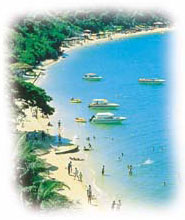 The second-largest island in the Gulf of Thailand dominates an idyllic 80-isle archipelago. Alluring expanses of soft, white- sand beaches beckon, and inland, as far as the eye can see, graceful coconut palms sway like green parasols. Tourism and coconuts keep the economy ticking over; aside from food and drink, the palms provide thatch for roofing, fibre for rope or matting, and oil for candles, soap and food products. When the islanders are not harvesting the coconuts, they’re busy cultivating rice in the paddies, out at sea fishing or—more likely nowadays—catering to the visitors. The second-largest island in the Gulf of Thailand dominates an idyllic 80-isle archipelago. Alluring expanses of soft, white- sand beaches beckon, and inland, as far as the eye can see, graceful coconut palms sway like green parasols. Tourism and coconuts keep the economy ticking over; aside from food and drink, the palms provide thatch for roofing, fibre for rope or matting, and oil for candles, soap and food products. When the islanders are not harvesting the coconuts, they’re busy cultivating rice in the paddies, out at sea fishing or—more likely nowadays—catering to the visitors.
Koh Samui was “discovered” belatedly because of its relative remoteness, some 560 km (350 miles) south of Bangkok, but when they built the island’s airport, the curtain rose on main-line tourism.
The ferry port of Nathon on the west coast is the only real town. It’s the place for travel agencies, money changers, the post office, dive shops, motorbike hire, cheap shopping and a variety of bars and restaurants. But most of the beaches are on the opposite side of the island, along a 50-km (30-mile) ring road.
Near the airport, the tiny islet of Koh Fan is reached by a short causeway. On a hillock here—you can hardly miss it—sits the Big Buddha, a modern statue 12m (40 ft) tall. On the east coast, Chaweng is the most developed (and expensive) area, with luxury hotels and discos, shopping and sports facilities. At Lamai, with the secondbiggest beach—5 km (3 miles) long—the village’s Cultural Hall displays ancient Buddhist scriptures, traditional farm implements, and treasures brought to the island by 19th-century Chinese traders.
Only 14 km (9 miles) north of Koh Samui, the island of Koh Phangan has some perfect beaches and refreshing waterfalls. The principal port is Thong Sala, but many excursion boats go to the village of Hat Rin, on the southeast coast, known for its uninhibited party atmosphere.

Northern Thailand
Up near the intriguing borders of Laos and Burma, Northern Thailand maintains a charming inscrutability. The people speak different dialects from the rest of Thailand, or their own tribal languages. Smiles go some way to aiding communication.
The North looks different too, with fertile plains and mountain country—even refreshing waterfalls. Because of the northeast monsoon, the region cools off between November and February. Wearing a sweater is a delight for travellers from muggy Bangkok. The lush countryside produces everything from rice to exotic fruits, and flowers from orchids to poppies.
The cities of northern Thailand are the springboards for expeditions into the country of the hill tribes, and with good roads and a sophisticated tourist infrastructure, the North is thriving. Aside from all the sights to see, a big “plus” is the proud people. Not only are they handsome and friendly, they have a talent for art and handicrafts; shoppers go wild in the workshops and the teeming markets.
Chiang Mai
The metropolis of the north was founded late in the 13th century by King Mengrai the Great. The hotels, shopping and nightlife are along the Ping River, but the heart of Chiang Mai is the original walled-and-moated square enclosing the old city. Mengrai meant business: they say he rushed construction of the city wall by assigning 90,000 men to work around the clock. Parts of the original wall are still there, and so is a monastery the king himself established.
Wat Chiang Man occupies a tranquil enclave in the northeast part of the old town, on Rachpakinai Road. Mengrai, a devoted Theravada Buddhist, is said to have taken up residence in the monastery while the town was built around him. Two precious religious images—the tiny Crystal Buddha and the Marble Buddha—are protected by bars and glass. Far more ancient than the monastery itself, the images are carried through the streets during April’s riotous Songkran festival, marking the Buddhist new year. Rain-making power is attributed to the Crystal Buddha, from the 7th century—just what the farmers want to believe in at the end of the dry season. Rounding out the historic attractions: a chedi thought to be a 15th-century copy of the original, surrounded by sculptured elephants.
Wat Chedi Luang, on Phra Pokklao Road, has been the scene of two famous disasters in its six-century history. This is where King Mengrai is said to have been zapped by a bolt of lightning. And in the 16th century, the giant chedi was decapitated by an earthquake, but it’s still a formidable monument.
Of the hundreds of temples in Chiang Mai and vicinity, the largest is Wat Phra Singh, on the road of the same name in the western part of the old city. According to legend, the site was chosen (in 1345) because this is where the chariot carrying a precious image of the Buddha broke down. Some of the buildings here are distinguished by elaborate wood carving—still a speciality of local artisans.
Beyond the walled city, near the motorway, a temple worth seeing is Wat Ched Yod, with some splendid stucco interpretations of deities. The temple is said to have been constructed in the
middle of the 15th century as the site of the international Buddhist conclave. The chedi is unique in northern Thailand—an amalgam of seven small pinnacles.
A temple with a view, Wat Phrathat Doi Suthep, is a 25-minute bus ride from Chiang Mai—uphill on a steep zigzag road. Once you’re there, a stairway of some 300 steps mounts from the parking area, swarming with would-be guides, hawkers and beggars, to the wat itself. For pilgrims with limited energy or devotion, there is the alternative of a cable-car. Legend says the exertion of the climb proved too much for a white elephant carrying holy relics up the mountain in the 14th century. When the elephant gasped its last here, it was considered a divine message and the temple was built on the spot. The relics are housed in a gold-plated chedi framed by royal gilt parasols.
A few kilometres past the monastery is Phu Ping Palace, a hilltop home of the Thai royal family. When the King and Queen are not in residence, which is most of the time, the grounds are open to the public at weekends and on holidays. The gardens are lovely and the view truly inspiring.
Beyond the palace, the village of Doi Pui is the closest place to Chiang Mai where you can see the life of a hill tribe. Because of its accessibility, the hamlet has lost its innocence, but the residents—members of the Hmong (or Meo) tribe—live essentially as they have always done. There is one big exception, though: they understand the money economy of the world outside; the villagers sell souvenirs and also charge to have their pictures taken. Doi Pui is certainly commercial, but if you’re too pressed for time to visit a more unspoiled hill-tribe village it’s worth seeing this one.
Anyone interested in Thai handicrafts will want to make the detour to San Kamphaeng, 13km (8 miles) east of Chiang Mai. The road is lined with workshops, factories and stores specializing in silks, silverware, wood-carving, lacquerware and ceramics. Prices are “flexible”—subject to haggling. Nearby Bor Sang is where those colourful Thai umbrellas and parasols come from. You can watch them being hand-produced, and order one to your own specifications.
On the way to Lamphun, south of Chiang Mai, the old road, shaded by giant trees, cuts through rich agricultural land. A prime crop here is longan—lamyat in Thai—a lychee-like fruit that’s prized all over Asia. Every August there’s a longan festival in Lamphun (to be pronounced Lampoon).
The city was founded in ad 660 by Queen Chama Devi, ruler of the Mon kingdom. King Mengrai captured it in 1281, a devastating blow for the Mons. For some of the background, visit the modern National Museum in the centre of town. Across the street, Wat Phra That Haripunjaya claims to have the biggest gong in the world. The central chedi is said to be more than a thousand years old.

Just out of town, Wat Chama Devi (also known as Wat Kukut) was founded by Queen Chama Devi herself. Still standing is a prototype of a five-tiered chedi with 60 Buddha images in niches around the sides. This pyramidal shrine is the last resting place of the Mon queen.
Elephants used to be the tractors of the forest, hauling teak logs down to the rivers and carrying loads (and people) through difficult terrain. Now they are mainly in show business: at the Mae Taem elephant camp 64 km (40 miles) north of Chiang Mai you can see them demonstrating their skills and THBing, and perhaps take a ride.
Chiang Rai
The grid of wide, straight streets of Chiang Rai looks like something out of the American midwest. In fact, a well-meaning American missionary laid out the modern town plan. But it was the great King Mengrai who founded Chiang Rai in the 13th century.
Thailand’s northernmost provincial capital has its quota of temples, though none of overwhelming importance. Wat Phra Kaeo is where the Emerald Buddha, now in the temple of the same name in Bangkok, was discovered; a replica now stands in its place. Otherwise, the thing to see is the big municipal market in the centre of town, featuring fish, foodstuffs and local colour. Chiang Rai is mainly interesting as a base for excursions to the Golden Triangle and hill-tribe villages. After a hard day’s trekking, it’s a relief to know the town offers a choice of comfortable, even luxurious, hotels and dependable restaurants.
Golden Triangle
Thailand, Laos and Burma come together at the confluence of the Mekong and Ruak rivers, an area dubbed the Golden Triangle. There are no border crossings here, no international ferries or bridges, though drug smugglers don’t seem to have been bothered by this handicap. The town of Sop Ruak announces itself as the apex of the Golden Triangle; souvenir peddlers and hotels and guesthouses await the crowds. The Thai government has acted to clamp down on the drug business, so most of the poppy cultivation, processing and trading is across the way in Laos and Burma. The area is still a leading contributor to the world’s supply of heroin, but the nefarious activities of the drug lords take place well out of sight.
Mae Hong Sorn
A tortuous but breathtakingly beautiful 8-hour drive, or a 30-minute flight from Chiang Mai, the little town of Mae Hong Sorn (or Son) is squeezed between the mountains and the border with Myanmar. Picturesque Burmese-style pagodas and stupas are reflected in Jongkhum Lake, and people from the hill tribes come to buy and sell in the morning markets. Strangest are the Padang, “long-necked” women who stretch their necks with increasing numbers of rings in imitation, it’s said, of the female dragon from which they’re descended.

What to see in Thailand |
 A good place to start is Royal Bangkok, the oldest part of the city on the Chao Phraya river. The Grand Palace is a fabulous complex where royal, religious and government buildings huddle together inside a crenellated wall. Among the pinnacles and spires, gateways guarded by oriental monsters, banquet halls and cloisters, Wat Phra Kaeo stands out. It is the royal chapel and Temple of the Emerald Buddha, protected by a nine-tiered umbrella and surrounded by gold murals. The Emerald Buddha is made of jade and considered so sacred that the king himself brings it ritual offerings and changes its seasonal dress. The centrepiece of the complex is Chakri Maha Prasad, topped by a chedi (shrine). A golden urn beneath the central spire contains the ashes of the Chakri kings.
A good place to start is Royal Bangkok, the oldest part of the city on the Chao Phraya river. The Grand Palace is a fabulous complex where royal, religious and government buildings huddle together inside a crenellated wall. Among the pinnacles and spires, gateways guarded by oriental monsters, banquet halls and cloisters, Wat Phra Kaeo stands out. It is the royal chapel and Temple of the Emerald Buddha, protected by a nine-tiered umbrella and surrounded by gold murals. The Emerald Buddha is made of jade and considered so sacred that the king himself brings it ritual offerings and changes its seasonal dress. The centrepiece of the complex is Chakri Maha Prasad, topped by a chedi (shrine). A golden urn beneath the central spire contains the ashes of the Chakri kings.
 Landward tours visit a rubber plantation, a gemstone mine and the Elephant Kraal where the gentle giants show off their skills. Shopping centres on the main street of south Pattaya and in the hotel boutiques. Off-the-peg fashion, shells, jewellery and trinkets catch the eye. Nightlife, also concentrated round south Pattaya, includes discos and open-air bars with some of the same dubious attractions as Bangkok’s Patpong. Hotel nightclubs put on a variety of musical shows.
Landward tours visit a rubber plantation, a gemstone mine and the Elephant Kraal where the gentle giants show off their skills. Shopping centres on the main street of south Pattaya and in the hotel boutiques. Off-the-peg fashion, shells, jewellery and trinkets catch the eye. Nightlife, also concentrated round south Pattaya, includes discos and open-air bars with some of the same dubious attractions as Bangkok’s Patpong. Hotel nightclubs put on a variety of musical shows. 

